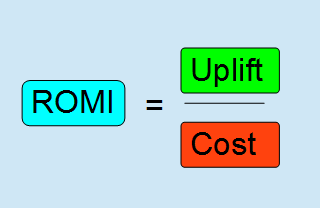As a marketer you should always remember that if you cannot evidence the value from your marketing activities don’t be surprised the budget gets cut!
Return On Marketing Investments (or ROMI) is a clear way to calculate that value.
ROMI is defined as a ratio between uplift (additional value that your marketing activity provided minus cost of the activity) and the cost of that activity.

Let’s see an example.
A company ABC sells chairs online. Before the display ad campaign the revenue was $100,000 in month (control value) with $20,000 gross profit.
A company launched display ad campaign and the revenue grows to $125,000 in the given month with gross profit of $25,000.
Campaign cost is $4,000.
What is the ROMI?
Uplift = Additional value – cost of campaign = ($25,000-$20,000-$4,000)=$1,000
ROMI = $1,000/$4,000 = 0.25=25%
If the ROMI is negative – you are doing something wrong, because you spent on the marketing more than it brings in to the business.
Sounds simple? Well, it is, but the devil here is in the details:
- What should we count as an additional value?
- What should we count as costs?
- What is the best control value?
The answers aren’t too obvious.
Value side
Most obvious additional value is incremental gross profit (revenue minus cost of goods and other variable expenses). Say in ‘normal’ time (no any campaign) you sell 20 units per day and and during campaign you sells 25 units per day. So you sell 5 more units per day and therefore grabbing a gross margin (sale price – cost of goods) for this additional 5 units per day and 150 units per month.
But is it the only value provided?
What about customers who were brought to your store by promotion, but purchased after campaign month? Should we count delayed purchases or maybe something like Lifetime Customer Value? Is there any other value that the campaign provides (email subscribers, increased brand recognition, social media activity, PR, in-store traffic lift)? It may be a good idea to think about that, aside of calculation it may help you to build your campaign such a way that maximises the value it delivers.
Costs side
On the other hand cost part of equation may be not so simple as well: selling additional units may cause you some additional expenses like hiring more staff to process orders, more warehouse space to store inventory, an extension of credit line, etc, etc.
For promotion campaign, if you give customer discounts, you should calculate reduced margin and take into account such not very pleasant effects as stockpiling (your regular customers buying products in advance, while it is discounted and therefore your future sales suffer) and cannibalization (when sales of other products drop due to promotion).
Control sample
As you may guess, selection of control sample isn’t very trivial too. It is important to establish control such a way to minimize the effect of external factors that have nothing in common with promotion. For example it isn’t correct to compare result of your January campaign with December sales data as a control for the most retail businesses due to Christmas sales hike.
So, while the concept of ROMI is simple, it is important to do your math right. To help you in that I plan to build an online ROMI calculator, so stay tuned!
Update: the calculator is ready, click here to use it and calculate your campaign ROMI
4 thoughts on “Return on marketing investments (ROMI)”